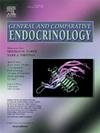An insight into the molecular mechanisms of persistent organic pollutants (POPs) mediated dysregulation of glucose and lipid homeostasis in Heteropneustes fossilis
IF 2.1
3区 医学
Q3 ENDOCRINOLOGY & METABOLISM
引用次数: 0
Abstract
The study emphasises how ubiquitous persistent organic pollutants (POPs) are and how terrible they are for the environment, specifically because of their tendency to build up in living things and cause a variety of health problems, including diabetes, obesity, and cardiovascular disorders. Due to POPs affinity for lipid-rich tissues, they accumulate in a variety of organs, where they cause metabolic disruption and initiate various anabolic pathways. Studies that use fish as a model organism clarify the metabolic effects of POPs, demonstrating non-adipose lipid accumulation and abnormal glucose homeostasis. Further research on molecular mechanisms shows that POPs interact with gluconeogenic enzymes, causing blood glucose levels to rise. These results are supported by histological and biochemical examinations of fish exposed to POPs, which show changes in lipid composition and cause cellular damage. Molecular docking computational studies demonstrate POPs propensity for binding to gluconeogenic enzymes, providing insight into their potential to promote hyperglycaemia. This study provides a thorough summary of POPs harmful effects on organisms, highlighting their molecular and toxicological, impacts while arguing for better knowledge of their toxicity to vertebrates’ developing embryos.

求助全文
约1分钟内获得全文
求助全文
来源期刊

General and comparative endocrinology
医学-内分泌学与代谢
CiteScore
5.60
自引率
7.40%
发文量
120
审稿时长
2 months
期刊介绍:
General and Comparative Endocrinology publishes articles concerned with the many complexities of vertebrate and invertebrate endocrine systems at the sub-molecular, molecular, cellular and organismal levels of analysis.
 求助内容:
求助内容: 应助结果提醒方式:
应助结果提醒方式:


